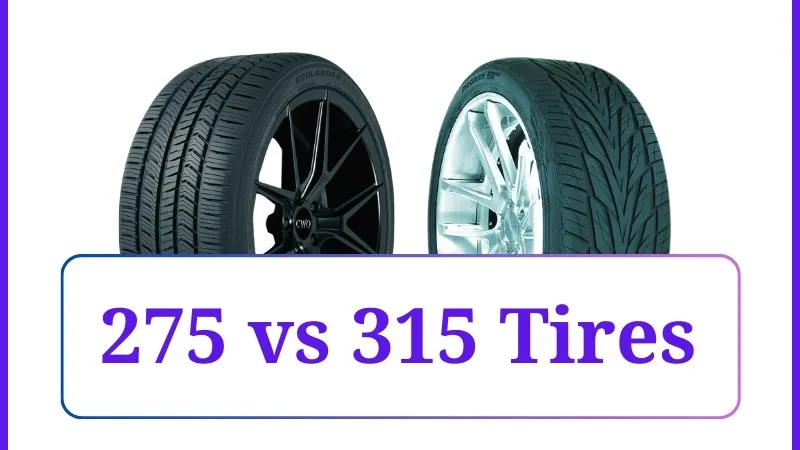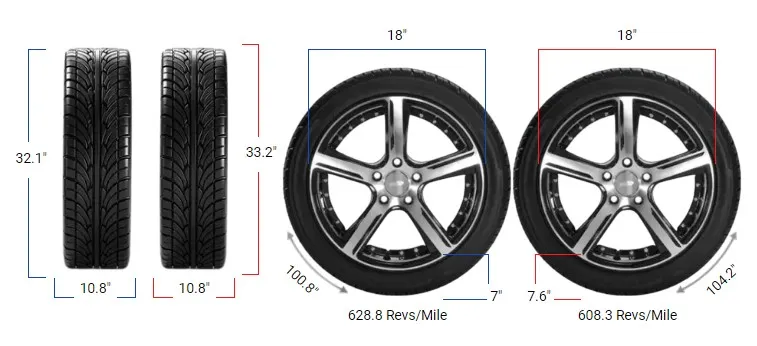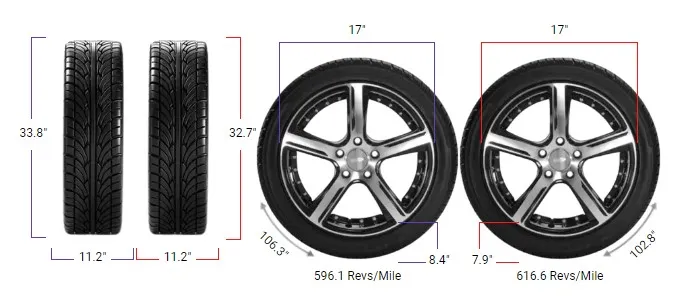275 vs 315 Tires

The most apparent difference between 275 and 315 tires is the width. The 315 tire is considerably wider than the 275, which directly impacts how the vehicle handles, how much traction it has, and the overall look.
Wider tires, like the 315, typically provide better traction due to the larger contact patch with the road. This increased contact area can improve stability, especially during high-speed driving or when tackling challenging terrains.
On the other hand, the narrower 275 tire can offer better fuel efficiency and more responsive handling.
It is a practical choice for those who want a balance between performance, comfort, and economy without the additional weight and resistance associated with a wider tire.
275 vs 315 Tires
This chart features popular tire sizes, detailing their overall diameter percentages and interchangeability capabilities.
| Tire Pair | Difference | Interchangeable |
|---|---|---|
| 275/70r17 vs 315/70r17 | +6.81% | No |
| 275/55r20 vs 315/70r17 | +7.65% | No, rim sizes differ |
| 275/40r17 vs 315/35r17 | +0.08% | Yes |
| 315/70r17 vs 275/55r20 | -7.10% | No, rim sizes differ |
| 275/70r17 vs 315/70r16 | +3.71% | No, rim sizes differ |

Fitment Guide
The ideal rim width range for 275 tires is 9.0, 9.5, 10.0, and 10.5 inches, while for 315 tires, it is 10.0, 10.5, 11.0, and 11.5 inches.
There is an overlap at 10.0 and 10.5 inches, meaning both sizes can be mounted on rims of these widths, providing an acceptable balance of performance, safety, and comfort.
It is essential that the aspect ratio and rim diameter remain consistent. Alternatively, if these dimensions differ, the overall diameter difference should be within 3% to maintain proper vehicle handling, speedometer accuracy, and safety. Meeting these conditions helps ensure that the new tire setup performs as expected.

On-Road Impact
Switching from 275 to 315 tires significantly impacts how your vehicle behaves on the road. The increased width of the 315 tire means a larger contact area with the road, enhancing traction and stability, particularly during high-speed driving and cornering.
This can provide a more confident and planted feel, making it ideal for those who enjoy spirited driving or need extra stability when towing heavy loads.
However, with this increase in width comes a downside: higher rolling resistance. The added resistance from the wider 315 tire can negatively affect fuel efficiency, leading to higher fuel consumption.
Drivers may also notice that the steering feels heavier compared to the 275, which can make tight maneuvering or parking slightly more challenging. Furthermore, wider tires often produce more road noise, which can affect ride comfort during long journeys.

Off-Road Impact
For those who frequently venture off the beaten path, the 315 tire offers several benefits. The wider footprint of the 315 provides better grip on loose and uneven surfaces such as gravel, mud, and sand.
This enhanced traction can make all the difference when navigating challenging trails or climbing steep inclines. However, there are trade-offs to consider.
The increased width may make it more difficult to navigate narrow off-road paths, and the added weight of the 315 tire can put more strain on the vehicle’s suspension and steering components. This can lead to increased wear over time, particularly in rough off-road conditions.
Pros of Switching to 315 Tires
- Improved Traction: The larger contact patch of the 315 tire results in better grip, which is particularly advantageous in high-speed scenarios or challenging off-road conditions.
- Enhanced Stability: The increased width offers greater stability, especially when towing or carrying heavy loads, making it an excellent choice for trucks and SUVs.
- Aggressive Look: The wider stance of the 315 tire gives a more aggressive, muscular appearance to the vehicle, which is often desirable for truck and SUV owners.
Cons of Switching to 315 Tires
- Lower Fuel Efficiency: The increased rolling resistance of the 315 tire can lead to reduced fuel efficiency, resulting in higher fuel costs over time.
- Heavier Steering Feel: Wider tires tend to make the steering feel heavier, which could impact maneuverability, especially in urban settings or tight spaces.
- Increased Component Wear: The added width and weight can place additional stress on suspension and steering components, potentially leading to increased maintenance needs.

Pros of Staying with 275 Tires
- Better Fuel Economy: The narrower 275 tire offers reduced rolling resistance, resulting in better fuel efficiency, which is ideal for daily commutes or long-distance driving.
- Lighter Handling: The narrower width makes for lighter steering, making the vehicle easier to maneuver in tight spaces and providing a more responsive feel.
- Reduced Wear on Components: The reduced weight and footprint of the 275 tire put less strain on the vehicle’s steering and suspension components, potentially increasing their longevity.
Cons of Staying with 275 Tires
- Reduced Traction: Compared to the wider 315 tire, the 275 provides a smaller contact area, which means less traction and stability in certain driving conditions, particularly off-road or during high-speed cornering.
- Less Aggressive Aesthetic: The narrower profile of the 275 tire may not offer the bold, aggressive appearance that many truck and SUV owners prefer.
- Limited Off-Road Capability: While the 275 tire is suitable for some off-road scenarios, it may not provide the same level of traction and stability as the wider 315 tire in loose or uneven terrain.

Difference Between 275 and 315 Tires
The primary difference between 275 and 315 tires is their width. The 315 tire is significantly wider, providing a larger contact patch that enhances traction and stability. Both sizes share an overlapping ideal rim width range of 10.0 to 10.5 inches, allowing for potential swaps.
However, it’s crucial to ensure that the aspect ratio and rim diameter match or that the overall diameter difference remains within 3% to maintain optimal vehicle performance, safety, and comfort when switching between these tire sizes.
Can I Use 275 Tires Instead of 315?
Yes, you can use 275 tires instead of 315 if the rim width is within the overlapping ideal range of 10.0 to 10.5 inches and the overall diameter difference is within 3%.
This ensures that performance, safety, and comfort are not compromised. Additionally, verify that your vehicle has adequate clearance to accommodate the narrower tires to prevent any fitment issues or rubbing against other components.

Can I Use 315 Tires Instead of 275?
Yes, you can use 315 tires instead of 275 provided the rim width falls within the overlapping ideal range of 10.0 to 10.5 inches and the overall diameter difference does not exceed 3%.
The wider 315 tires can improve traction and stability, but it’s essential to ensure that your vehicle has sufficient clearance to avoid rubbing or interference with other parts, thereby maintaining optimal performance and safety.
Can You Put 275 Tires on 315 Rims?
Yes, you can put 275 tires on 315 rims as long as the rim width is within the overlapping ideal range of 10.0 to 10.5 inches.
This compatibility ensures proper tire fitment and maintains a balance between performance, safety, and comfort. Additionally, verify that the overall diameter difference is within 3% to prevent any adverse effects on vehicle handling and speedometer accuracy.
Can You Put 315 Tires on 275 Rims?
Yes, it is possible to put 315 tires on 275 rims if the rim width falls within the overlapping ideal range of 10.0 to 10.5 inches.
Ensure that the overall diameter difference remains within 3% to maintain vehicle safety and performance. Additionally, check that there is adequate clearance to prevent the wider tires from rubbing against the vehicle’s components, ensuring a proper and safe fit.
Our Observation
The decision between 275 and 315 tires ultimately comes down to your driving needs and preferences. If you are looking for improved stability, enhanced traction, and a more aggressive look, the 315 tire might be the better choice.
This is especially true for drivers who enjoy off-road adventures or frequently tow heavy loads. On the other hand, if fuel efficiency, lighter handling, and reduced component wear are your priorities, the 275 tire may be the more practical option.
Each tire size has its unique set of advantages and drawbacks, so it is crucial to weigh these factors to determine which is best for your situation.



